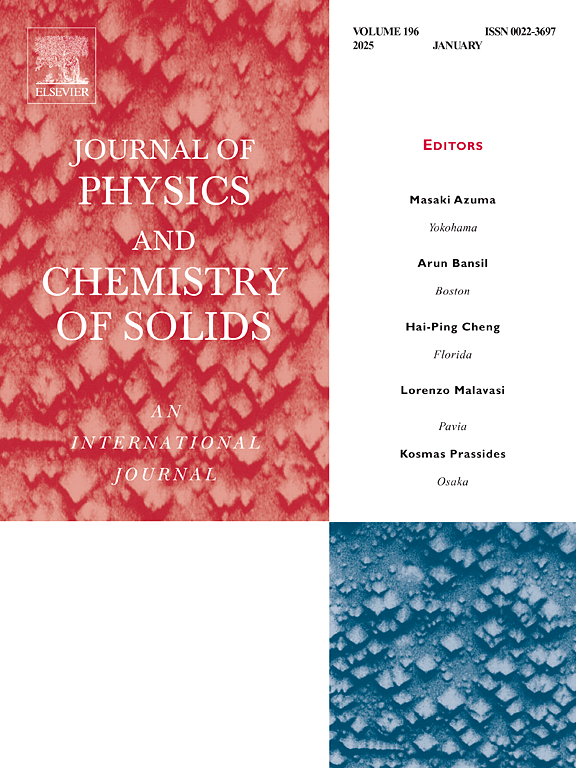新型Z-scheme p-n异质结光催化剂0D/3D CeVO4/MIL-88(a)的制备:增强光催化性能及机理研究
IF 4.9
3区 材料科学
Q2 CHEMISTRY, MULTIDISCIPLINARY
引用次数: 0
摘要
本文旨在合成一种在水环境下光催化降解抗生素的高效催化剂。为此,将零维(0D) CeVO4纳米粒子封装在主轴形(3D) MIL-88 (A)表面,采用溶剂热法制备CeVO4/MIL-88 (A) p-n异质结光催化剂,以增加复合光催化剂的活性位点。采用SEM、FT-IR、XRD、XPS和UV-vis光谱对所制备的光催化剂进行了表征。用可见光光催化降解盐酸四环素(TC)的效率来评价复合材料的光催化活性。结果表明,在优化条件下(CeVO4质量比为20%)制备的CVM2异质结光催化剂具有最强的光催化活性。在可见光照射下120 min, CVM2对水中TC (10 mg/L)的光催化降解效率达到81%,明显高于MIL-88 (A)和CeVO4。超氧自由基是反应体系中的主要活性物质,羟基自由基和空穴也参与了TC的降解。Ca2+、Na+、K+、Mn2+等阳离子和Cl−、CO32−等阴离子以及天然有机化合物FA对TC降解无明显影响。复合材料CVM2光催化性能提高的原因是CeVO4与MIL-88 (a)界面处形成了p-n内电场,增强了复合材料表面光生电荷的分离和转移能力。本文章由计算机程序翻译,如有差异,请以英文原文为准。
Fabrication of a novel Z-scheme p-n heterojunction photocatalyst 0D/3D CeVO4/MIL-88(A): enhanced photocatalytic performance and mechanism insight
This article aims to synthesize an efficient catalyst for the photocatalytic degradation of antibiotics in an aqueous environment. To this end,zero-dimensional (0D) CeVO4 nanoparticles were encapsulated on the spindle shaped (3D) MIL-88 (A) surface to fabricate a CeVO4/MIL-88 (A) p-n heterojunction photocatalyst by using solvothermal method, aiming at increasing the active sites of the composite photocatalyst. The prepared photocatalysts were characterized using SEM, FT-IR, XRD, XPS and UV–vis spectra. The photocatalytic degradation efficiency of tetracycline hydrochloride (TC) under visible light irradiation were used to assess the photocatalytic activity of the prepared composites. The results indicated that the CVM2 heterojunction photocatalyst fabricated under the optimized conditions (with a CeVO4 mass ratio of 20 %) had the strongest photocatalytic activity. Under the irradiation of visible light for 120 min, the photocatalytic degradation efficiency of CVM2 to TC (10 mg/L) in water reached 81 %, which was marked higher than that of MIL-88 (A) and CeVO4. Superoxide radicals were the main active species in the reaction system, and hydroxyl radicals and holes also contribute to the degradation of TC. Cations such as Ca2+, Na+, K+, Mn2+, and anions such as Cl−, CO32−, and natural organic compound FA did not have an obvious impact on TC degradation. The reason for the improvement of the photocatalytic performance of composite material CVM2 was due to the formation of a p-n internal electric field at the interface between CeVO4 and MIL-88 (A), which enhances the separation and transfer ability of photogenerated charges on the surface of the composite material.
求助全文
通过发布文献求助,成功后即可免费获取论文全文。
去求助
来源期刊
CiteScore
7.80
自引率
2.50%
发文量
605
审稿时长
40 days
期刊介绍:
The Journal of Physics and Chemistry of Solids is a well-established international medium for publication of archival research in condensed matter and materials sciences. Areas of interest broadly include experimental and theoretical research on electronic, magnetic, spectroscopic and structural properties as well as the statistical mechanics and thermodynamics of materials. The focus is on gaining physical and chemical insight into the properties and potential applications of condensed matter systems.
Within the broad scope of the journal, beyond regular contributions, the editors have identified submissions in the following areas of physics and chemistry of solids to be of special current interest to the journal:
Low-dimensional systems
Exotic states of quantum electron matter including topological phases
Energy conversion and storage
Interfaces, nanoparticles and catalysts.

 求助内容:
求助内容: 应助结果提醒方式:
应助结果提醒方式:


